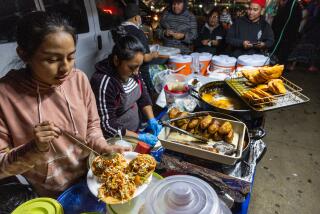Economic Crisis Triggers Boom in Cuban Crafts
- Share via
EL CANO, Cuba — A potter’s wheel sits in nearly every backyard of this village southwest of Havana, a reminder of a tradition that dates back to colonial times.
Until recently, most of the devices sat idle. Young people preferred modern trades to the ceramics that had supported their grandparents. Like El Cano, other Cuban towns were losing their traditional crafts--from basket weaving to needlework and leather.
But not anymore.
“In the past few years, there has been an explosion in Cuban crafts,” said Surnai Benitez, assistant director of the Cuban Cultural Foundation, a self-supporting government agency.
Cuba’s economic crisis and efforts to overcome it have unexpectedly turned into a formula for reviving crafts.
Increased tourism and import shortages have created a market at the same time that Cubans are looking for work that will earn them dollars so that they can buy cheese, pork, shoes and other products not available for sale in exchange for pesos.
Crafts markets convene daily on an empty lot by the Havana sea wall and on the plaza outside the colonial cathedral. Membership in the Cuban Artistic Craftsmen’s Assn., the elite group that sponsors top-level exhibits and workshops, has grown to more than 4,000 from just a few hundred at the beginning of this decade, said Alejandro Alejo, a board member and weaver.
One of the new members is Rigoberto Gomez Suliman, a journeyman electrician who once lived here and commuted to Havana every day. Then, six years ago, the buses stopped running. The government--the nation’s only legal employer--began layoffs. The collapse of the Soviet Union, Cuba’s main trading partner and source of foreign aid, had reached El Cano.
Unable to support his family on a monthly salary of 225 pesos--about $11--even if he could get to work, Gomez Suliman looked to his brother, the eldest of four siblings and the only one who carried on the family tradition of pottery. Because they are relatives, he could legally work in his brother’s shop while he learned to turn clay.
Within two years, he had opened his own workshop and was winning prizes for clay sculptures, which he signs Suliman. Now 36 and bearded, he is one of El Cano’s best-known potters. Believers in Santeria--the Afro-Cuban religion--seek him out to make the elaborate jars used in their ceremonies. He also makes cups for sidewalk coffee stands, one of Cuba’s newly legalized family businesses. At less than 25 cents each, his clay cups are far cheaper than imported glass.
Gomez Suliman estimates that he earns three times his wages as an electrician, while spending less on transportation and clothing. “I did this out of necessity, but it has turned out to be my calling,” he said.
Now he is teaching his sons, 6 and 8, the craft. “I want them to get a good education, but to always know pottery, just in case,” he explained. He also needs them to help him because he cannot legally hire an assistant.
The big advantage of ceramics, he said, is that none of the raw materials must be imported. Everything from clay to enamel pigments are abundant in Cuba, an important consideration for a country that cannot afford to buy abroad.
Other crafts folk are not so fortunate. Lidia, who asked that her last name not be used, relies on the black market to buy leather for the sandals she makes. Because she is an architect--a practicing professional--she is not entitled to buy from the government leather monopoly. Nor can she legally sell her wares. Still, she pedals her bicycle to the cathedral twice a week and leaves newly made sandals with a friend who sells them. “It’s completely illegal,” she admits, “but I need the money.”
Her black-market source has undoubtedly pilfered the leather from government supplies, she acknowledges. Such theft led the government to close the cathedral market 15 years ago.
But a similar crackdown would be far more difficult now, with so many families relying on crafts for their livelihood, craftsmen said.
Even the government relies on income from crafts. The Cuban Cultural Foundation, which was once government subsidized, now turns over one-third of its earnings to the national budget, earmarked for cultural activities.
More to Read
Sign up for Essential California
The most important California stories and recommendations in your inbox every morning.
You may occasionally receive promotional content from the Los Angeles Times.










